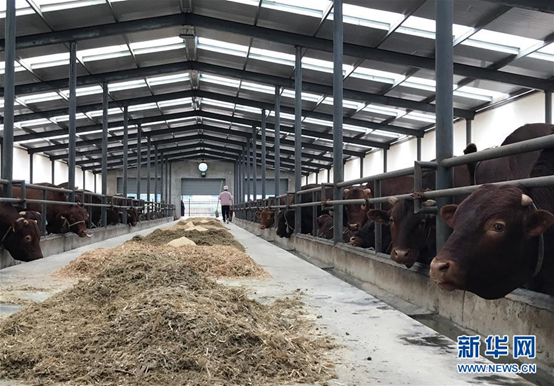Farmers in Gansu become more prosperous by raising special breed of red cattle
p.china.org.cn by Ye Kai,December 24, 2020 Adjust font size:
Fifty-four-year-old Qi Xiaoping, resident of Jingning county, Gansu province, likes to take a walk on the mountain roads that run through the region before he begins working every day. He used to want to leave the impoverished village that he lives in as quickly as possible but has come to enjoy it the more time he spends in it.
The faint image of a cowshed appeared through the mist that engulfed the valley at the foot of a prominence that he hiked up on a recent morning. Qi struggled with poverty for half his life but eventually became much more prosperous by raising a special breed of red cattle in his local area.
“I have made more than 100,000 yuan (US$14,720) in less than a year,” Qi mentioned while facing the Loess plateau with the sky rising behind him. “Life is very good!” He said happily when he met a poverty relief official from Tianjin municipality on his way back to the foot of the mountain.
Tianjin’s Wuqing district partnered with Jingning in 2017 via a cooperative poverty reduction system that involves localities in east China helping those in western parts of the country. Capable and down-to-earth Wuqing official Guo Manshan was appointed deputy county mayor of Jingning later that year. He conducted a thorough investigation of the industries that Jingning’s residents traditionally engaged in in order to determine the best way to help them escape from poverty and become more prosperous and ultimately decided that it would be best to pursue new cattle farming endeavors.
Guo thought that Jingning should focus on raising Pingliang red cattle in particular due to their advantages over the cattle that had generally been raised in the area. The breed is created via the ((local yellow cattle × Qinchuan cattle) × Limousin cattle) × South Devon cattle formula and is much larger and heavier than local yellow cattle and Qinchuan cattle. It also yields a higher proportion of high-quality beef than local yellow cattle.
Jingning’s farmers were skeptical of Guo’s plan at first because many of them lost money raising cattle in the past. Their concerns dissipated when they learned about the benefits of his proposal, however, and they quickly became enthusiastic about it.
“The cows that Jingning’s residents raised in the past were not as big as the red cattle that we breed now, and farmers only made about 3,000 to 4,000 yuan (US$442 to US$589) per animal,” Qi explained. “People sometimes had to sell their animals for even less if they needed money.”
The Wuqing government has invested a total of 28.97 million yuan (US$4.26 million) in Jingning’s cattle industry in the last three years and has provided technical support to the county’s farmers, which has helped make it possible to extend its value chain, establish standardized cowsheds and cattle cooperatives, and develop the industry in other ways.
“Farmers that sell Pingliang cows that weigh more than 550 kg receive an extra three yuan (US$0.44) per kg , and impoverished farmers are eligible for 400 yuan (US$59) of subsidies per head,” explained Li Gaoqiang, mayor of Jingning’s Jieshipu town. “Poverty-stricken farmers currently earn about 2,000 yuan (US$294) more per head than they used to.” He also explained that leading enterprises have established cattle farms in the area and adopted operation models that involve “seeds for crops that are grown for use as feed being supplied to local farmers, cattle being bred in a decentralized manner, fattening occurring in cowsheds that are located at a centralized base, and sales and marketing efforts being conducted in a unified manner.”
Jieshipu established the cattle farming base in order to promote the development of its cattle industry. The cows that are housed in its cowsheds are fed scientifically cultivated wheat straw, corn silage, and compound feed, which helps improve meat quality and demand.
Specialized enterprises quickly became interested in the cows that are raised in Jieshipu. Hong Kong-based companies have signed purchase orders that have helped bring the town’s annual export volume to 3,000 head.
“The people who raise Pingliang cows are diligent, and the animals grow quickly,” cattle farmer Sun Jianhua stated while grinning with pride. “The scientifically managed feed that they consume helps them grow to 600 to 700 kg in a matter of months.”
“The grass-and-livestock-based circular agriculture system that is being utilized in Jieshipu has contributed to cattle inventory rising to 8,200 head in our town,” Li said.
Demand for feed has increased greatly as more and more purchase orders for Pingliang red cattle have come in. Seven hundred twenty impoverished households earn an average of over 8,000 yuan (US$1,178) more per year from the forage that they currently grow compared to the traditional forage that they grew before.
One notices particularly conspicuous white characters that translate to “growing quality forage grass and raising red cattle in order to achieve prosperity” painted on a series of red signs mounted on a green and gray wall of a cattle shed at the Pingliang red cattle husbandry base in Jieshipu as one drives out of town and onto the winding roads that run through the green mountains and forests in the area – an apt mantra for the farmers involved with the endeavor.

Cattle farmer Sun Jianhua stands outside a cowshed at the Pingliang red cattle husbandry base in Jieshipu town, Jingning county, Pingliang prefecture, Gansu province. (Wang Hui/Xinhua)

The interior of a cowshed at Jieshipu’s Pingliang cattle farming base (Wang Hui/Xinhua)
3edea7b2-4f52-435d-8631-a96ba143ccb5.png)